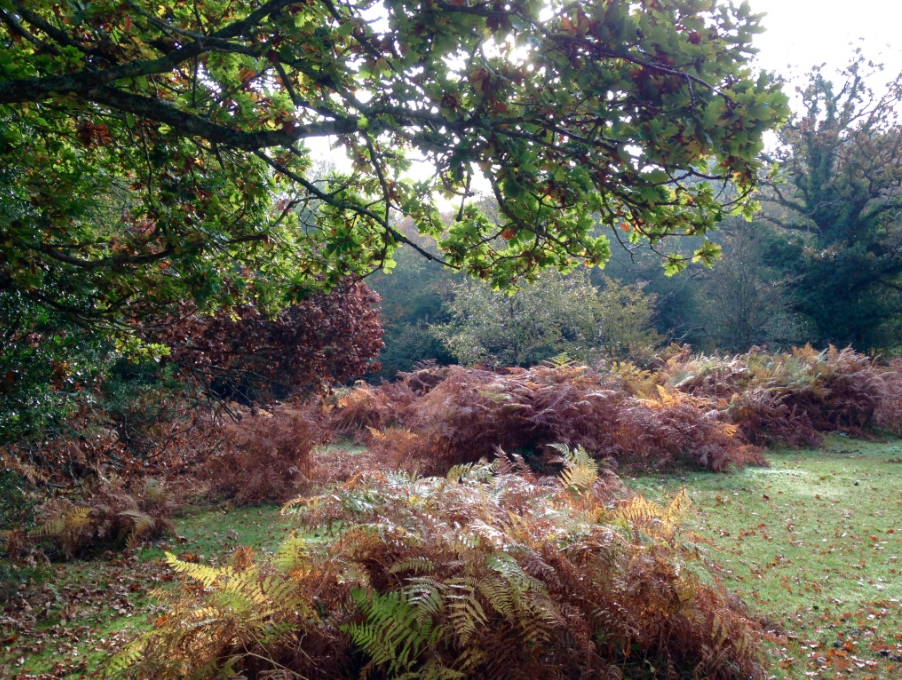
Late autumn in the New Forest is filled with warm colour
Autumn in the New Forest is a spectacular time of year. The warm colours of orange, russet, and red that are on display in the canopies of the trees and over the heathland contrast with the wintry temperatures on clear days. No photograph could ever reproduce the raw breath-taking beauty and atmosphere that such scenery stimulates within our senses. Scrunching through fallen leaves, while out looking for my free-roaming ponies, brings back memories of early childhood. My small feet, wrapped in newspaper to insulate against the cold, would be stuffed into oversized hand-me-down wellington boots, which I would use to make trenches through the piles of leaf-litter. As a nipper I never ever remember feeling bored at any time I was out-of-doors. There was always so much to observe and be aware of. It’s just the same for me today. I use all of my senses to try and attune myself to the landscape. As the leaves begin to fall from the trees it’s getting easier to spot the ponies that take shelter in the wooded areas. They are beginning to change into their winter coats, with the short smooth hairs that gave a gleam to their bodies in summer being slowly replaced by the longer shaggy hairs that will help to repel and redirect winter rain. In the early mornings, before the sound of commuter traffic floods the landscape, I can hear the distinctive calls of the fallow bucks as they announce that their mating season – the rut – is underway.
Get the picture?
Rutting activity is usually most intense just after dawn, when the bucks attempt to secure as many does (female deer) as they can while seeing off other males. On still days the grunting noise of the bucks carries a good distance and every now and then may be replaced by the sound of clashing antlers as two males fight. It’s a very stressful time for the deer and the bucks are filled with testosterone, which makes them much more aggressive and, consequently, more dangerous. I always give the deer a wide berth at this time. Not so with other people – photographers – who are willing to go to extraordinary lengths, and at great personal risk, to obtain close-up photographs of deer behaviour during the rut. I have seen images, via social media, of deer in various stages of coitus that seem so intrusive the photos must have been taken without any regard for the animal’s wellbeing and may even constitute wildlife harassment. Such selfish behaviour is becoming a problem for many conservation areas, particularly where rare or ‘rewilded’ species are to be found. Guidelines have consequently been produced by the Royal Photographic Society for Nature Photographers to try to reduce the impact of their behaviour on their non-human subjects. Photographers to the New Forest would also be strongly advised to check with the Forestry Commission that their activities are not breaching any of the New Forest Byelaws and to obtain permission where appropriate. Watching wildlife is becoming big business and there are websites advertising where rutting deer may be viewed, not just in the New Forest but all over the country. It seems the more we become separated from the rest of the animal kingdom and the natural world, the more we want to somehow interact with it. Is it just me though, or does the notion of gathering to watch deer mating seem like a rather bizarre notion of a day out?

The deer rut occurs at autumn and is the mating season for the New Forest’s largest wild mammal
Guidelines for the Nature Photographer’s Code of Practice has been produced by the Royal Photographic Society in consultation with the RSPB and the three Statutory Nature Conservation Councils.
Photography in the New Forest is covered under Forestry Commission Byelaws, particularly where it occurs as part of an organised event or for commercial/educational purposes.
Forestry Commission Byelaws under Statutory Instrument 1982 No. 648
Please note: This article and the links attached are intended for general information purposes only and does not constitute legal advice.


You must be logged in to post a comment.